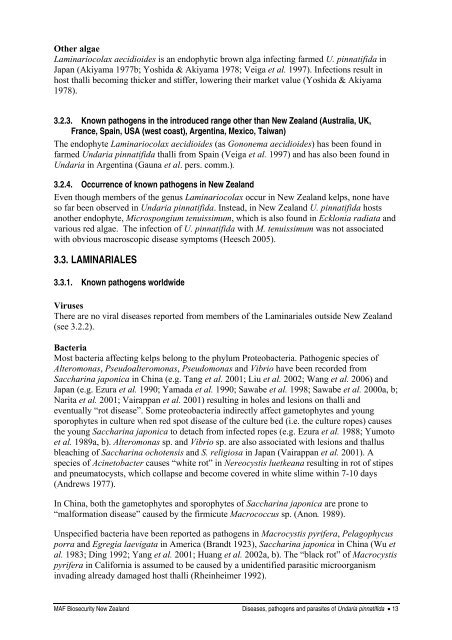Diseases, pathogens and parasites of Undaria pinnatifida
Diseases, pathogens and parasites of Undaria pinnatifida
Diseases, pathogens and parasites of Undaria pinnatifida
You also want an ePaper? Increase the reach of your titles
YUMPU automatically turns print PDFs into web optimized ePapers that Google loves.
Other algae<br />
Laminariocolax aecidioides is an endophytic brown alga infecting farmed U. <strong>pinnatifida</strong> in<br />
Japan (Akiyama 1977b; Yoshida & Akiyama 1978; Veiga et al. 1997). Infections result in<br />
host thalli becoming thicker <strong>and</strong> stiffer, lowering their market value (Yoshida & Akiyama<br />
1978).<br />
3.2.3. Known <strong>pathogens</strong> in the introduced range other than New Zeal<strong>and</strong> (Australia, UK,<br />
France, Spain, USA (west coast), Argentina, Mexico, Taiwan)<br />
The endophyte Laminariocolax aecidioides (as Gononema aecidioides) has been found in<br />
farmed <strong>Undaria</strong> <strong>pinnatifida</strong> thalli from Spain (Veiga et al. 1997) <strong>and</strong> has also been found in<br />
<strong>Undaria</strong> in Argentina (Gauna et al. pers. comm.).<br />
3.2.4. Occurrence <strong>of</strong> known <strong>pathogens</strong> in New Zeal<strong>and</strong><br />
Even though members <strong>of</strong> the genus Laminariocolax occur in New Zeal<strong>and</strong> kelps, none have<br />
so far been observed in <strong>Undaria</strong> <strong>pinnatifida</strong>. Instead, in New Zeal<strong>and</strong> U. <strong>pinnatifida</strong> hosts<br />
another endophyte, Microspongium tenuissimum, which is also found in Ecklonia radiata <strong>and</strong><br />
various red algae. The infection <strong>of</strong> U. <strong>pinnatifida</strong> with M. tenuissimum was not associated<br />
with obvious macroscopic disease symptoms (Heesch 2005).<br />
3.3. LAMINARIALES<br />
3.3.1. Known <strong>pathogens</strong> worldwide<br />
Viruses<br />
There are no viral diseases reported from members <strong>of</strong> the Laminariales outside New Zeal<strong>and</strong><br />
(see 3.2.2).<br />
Bacteria<br />
Most bacteria affecting kelps belong to the phylum Proteobacteria. Pathogenic species <strong>of</strong><br />
Alteromonas, Pseudoalteromonas, Pseudomonas <strong>and</strong> Vibrio have been recorded from<br />
Saccharina japonica in China (e.g. Tang et al. 2001; Liu et al. 2002; Wang et al. 2006) <strong>and</strong><br />
Japan (e.g. Ezura et al. 1990; Yamada et al. 1990; Sawabe et al. 1998; Sawabe et al. 2000a, b;<br />
Narita et al. 2001; Vairappan et al. 2001) resulting in holes <strong>and</strong> lesions on thalli <strong>and</strong><br />
eventually “rot disease”. Some proteobacteria indirectly affect gametophytes <strong>and</strong> young<br />
sporophytes in culture when red spot disease <strong>of</strong> the culture bed (i.e. the culture ropes) causes<br />
the young Saccharina japonica to detach from infected ropes (e.g. Ezura et al. 1988; Yumoto<br />
et al. 1989a, b). Alteromonas sp. <strong>and</strong> Vibrio sp. are also associated with lesions <strong>and</strong> thallus<br />
bleaching <strong>of</strong> Saccharina ochotensis <strong>and</strong> S. religiosa in Japan (Vairappan et al. 2001). A<br />
species <strong>of</strong> Acinetobacter causes “white rot” in Nereocystis luetkeana resulting in rot <strong>of</strong> stipes<br />
<strong>and</strong> pneumatocysts, which collapse <strong>and</strong> become covered in white slime within 7-10 days<br />
(Andrews 1977).<br />
In China, both the gametophytes <strong>and</strong> sporophytes <strong>of</strong> Saccharina japonica are prone to<br />
“malformation disease” caused by the firmicute Macrococcus sp. (Anon. 1989).<br />
Unspecified bacteria have been reported as <strong>pathogens</strong> in Macrocystis pyrifera, Pelagophycus<br />
porra <strong>and</strong> Egregia laevigata in America (Br<strong>and</strong>t 1923), Saccharina japonica in China (Wu et<br />
al. 1983; Ding 1992; Yang et al. 2001; Huang et al. 2002a, b). The “black rot” <strong>of</strong> Macrocystis<br />
pyrifera in California is assumed to be caused by a unidentified parasitic microorganism<br />
invading already damaged host thalli (Rheinheimer 1992).<br />
MAF Biosecurity New Zeal<strong>and</strong> <strong>Diseases</strong>, <strong>pathogens</strong> <strong>and</strong> <strong>parasites</strong> <strong>of</strong> <strong>Undaria</strong> <strong>pinnatifida</strong> • 13

















